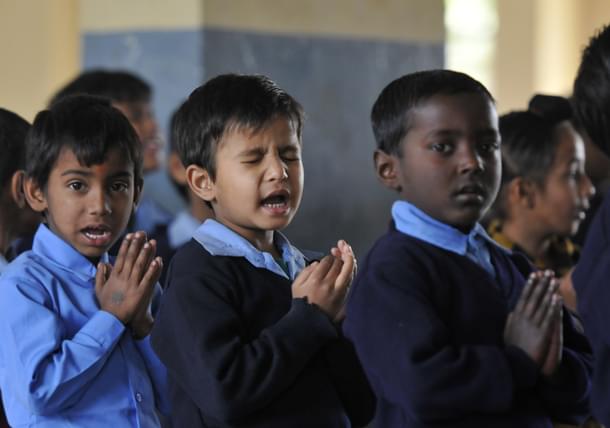Ideas
Your Highness, Lead Us Not From Light To Darkness
Aravindan Neelakandan
Jan 30, 2019, 05:54 PM | Updated 05:53 PM IST
Save & read from anywhere!
Bookmark stories for easy access on any device or the Swarajya app.


J B S Haldane (1892-1964) was a polymath and one of the architects of what is today known as Neo-Darwinism: the synthesis of Mendelian genetics and Darwinian evolution.
He was also a Marxist. He came out of Marxism the hard way. It took the pseudo-science of Neo-Lamarckism promoted by the USSR and the Marxist inquisition that Stalin unleashed on geneticists to shock Haldane out of his Marxism.
He came to India and started showing great admiration for ancient Indian darshanas while at the same time lamenting the present fall of Indians – particularly in the field of critical thinking. In an article he wrote in the Hindustan Times, Haldane, one of the greatest biologists of all times, observed:
Hinduism enjoins a scientific attitude and this is a great advantage for Indians in their approach to science. The repetition of Gayatri Mantra reminds one that earth, air, and sky are a glory and that it is one’s duty to think about them to the utmost of his power. If one out of hundred persons who repeat it would do the same, India would lead the world in science.‘Science and the Enquiring Mind’, ‘The Hindustan Times’, May, 18, 1956
One wonders what would be Haldane’s reaction if he were to know that nearly seven decades after he made that statement, the Supreme Court of India ordered a special bench to decide if a remarkable verse from the Upanishads exhorting humanity to move from darkness to light and from unreal to the real, violated secularism. The petitioner has construed the verses as a sectarian, dogmatic, religious prayer.
The problem seems to be the profoundness of Hindu dharma and the exponential increase in the quantum of cultural illiteracy in the country.
Haldane himself had observed that Hinduism is not a religion like the proselytising religions and that it is actually an attitude towards the universe which is compatible with the variety of religious and philosophical stands. If we can term a verse, asking to be led from darkness to light and from the unreal to the real, as against secularism, then tomorrow we may even call teaching of evolution as anti-secular. After all, does it not favour a Vedantic impersonal Spinozan concept of divinity and the absence of a creator god over the Islamo-Christian beliefs in a creator god?
Already, in Tamil Nadu, political parties have successfully stopped the introduction of the secular ‘BCE’ and ‘CE’ in the place of sectarian ‘BC’ and ‘AD’ as they allege the terms are – hold your breath – against secularism.
Sitaram Goel did prophetically call this kind of ‘secularism’ India’s perverted political parlance. Today, this particular brand of secularism is nothing but a fanatical hatred of proselytising religions towards India’s theo-diverse knowledge traditions that go by the name, Hindu dharma.
India as a nation and civilisation lives only to harbour and nourish this flame of diverse and pluralist knowledge and spiritual traditions – what Haldane called as attitude towards all existence that is compatible with a wide variety of philosophical systems and spiritual visions. Founding fathers of modern India, warts and all, understood intuitively this duty of the nation-state towards the Hindu nation. That would explain why the Indian Navy carries a Vedic verse in its motto and the Indian Air force, a Gita verse, and why the Upanishad verse Satyameva Jayate adorns the very emblem of this nation.
The logo of the National Council of Educational Research and Training carries the verse from Isavasya Upanishad. Problems arise because of intentional or inadvertent confusing of India being a Hindu nation with the state needing to be a secular state.
There can be no two opinions that the state has to be secular in the same way there should be no two opinions that India as a nation is Hindu, in the broadest, profoundest and deepest sense of the word.
The unfortunate identity disorder that has crept into the political psyche which blurred the difference between the two is at the root of the kind of problem that we face today, with the Supreme Court even admitting and assigning a special bench to a petition that should have been summarily dismissed with the contempt it deserves.
If at all we need anything very urgently in the curriculum, it is the need for the integration of vedic darshanas, Vedanta and Sankhya, Satkaryavada of vedic systems, Syadvada of the Jains, Pratityasamutpada of Buddhists etc, intelligently into the teaching of science, art and humanities.
This is a need that was felt very early in the history of the modern Republic of India. The report of the Education Commission, 1966, headed by eminent physicist and educationist Prof D S Kothari submitted to then the minister of education Muhammad Carim Chagla, has this to say regarding this aspect of education:
If we learn the lesson right, we can harness science to support rather than weaken our basic commitment to cultural and spiritual values. It should be our goal and obligation to re-interpret, and raise to a new level of understanding, the insight gained by the ancient seers as regards the fundamental problems of life, which in some ways is unique and ‘represents the quintessence of deepest insight into the happenings of the world.’
The last part of the sentence was taken from the work What is Life?, that famous book of physicist Schrodinger that changed the course of science in our times. The commission then proceeds to quote from the opening stanza of Kena Upanishad and elaborates. The commission in this context also quotes Jawaharlal Nehru saying that while we cannot be untrue to science, “less can we be untrue to those essential principles for which India has stood in the past throughout the ages.” And everyone but the most vilest India-hater would agree that the Upanishads represent that very “essential principles for which India has stood in the past throughout the ages”.
One would have expected India to have built upon these unique civilisational advantages a curriculum of science. No - it’s not about Vedic aeroplanes and Mahabharata nuclear missiles nor the anti-Darwin stupidity nor the conjuring tricks paraded as ‘powers’ by pseudo-guru cults. Such diseases of the mind that we see today come from the inferiority complex created by the cultural illiteracy that we have in the present day education system.
It is about creating a robust psychology of discovery and science of eternal values in all spheres of life. This civilisation has already shown how vedantic values can create a J C Bose and a George Sudarshan and we have today Manjul Bhargava and Subhash Kak. Yet, the products of this civilisational wisdom today stand more as exceptions than the result of the system. Had we created a system that integrate the values of the Upanishads and the spirit of Buddha and Shankara in our education, what a variety of great flowers would have blossomed in this land!
In a way, the Supreme Court has also created an opportunity if it chooses to use it well. It can say once and for all that what the Upanishads represent through the verses of ‘Asatoma Satgamaya ...’ is the very spirit and essence of India. If we lose them then we will lose the essence of nationhood. With the loss of that spirit, all institutions and instruments of the nation state will remain only as a body devoid of spirit.
Aravindan is a contributing editor at Swarajya.





